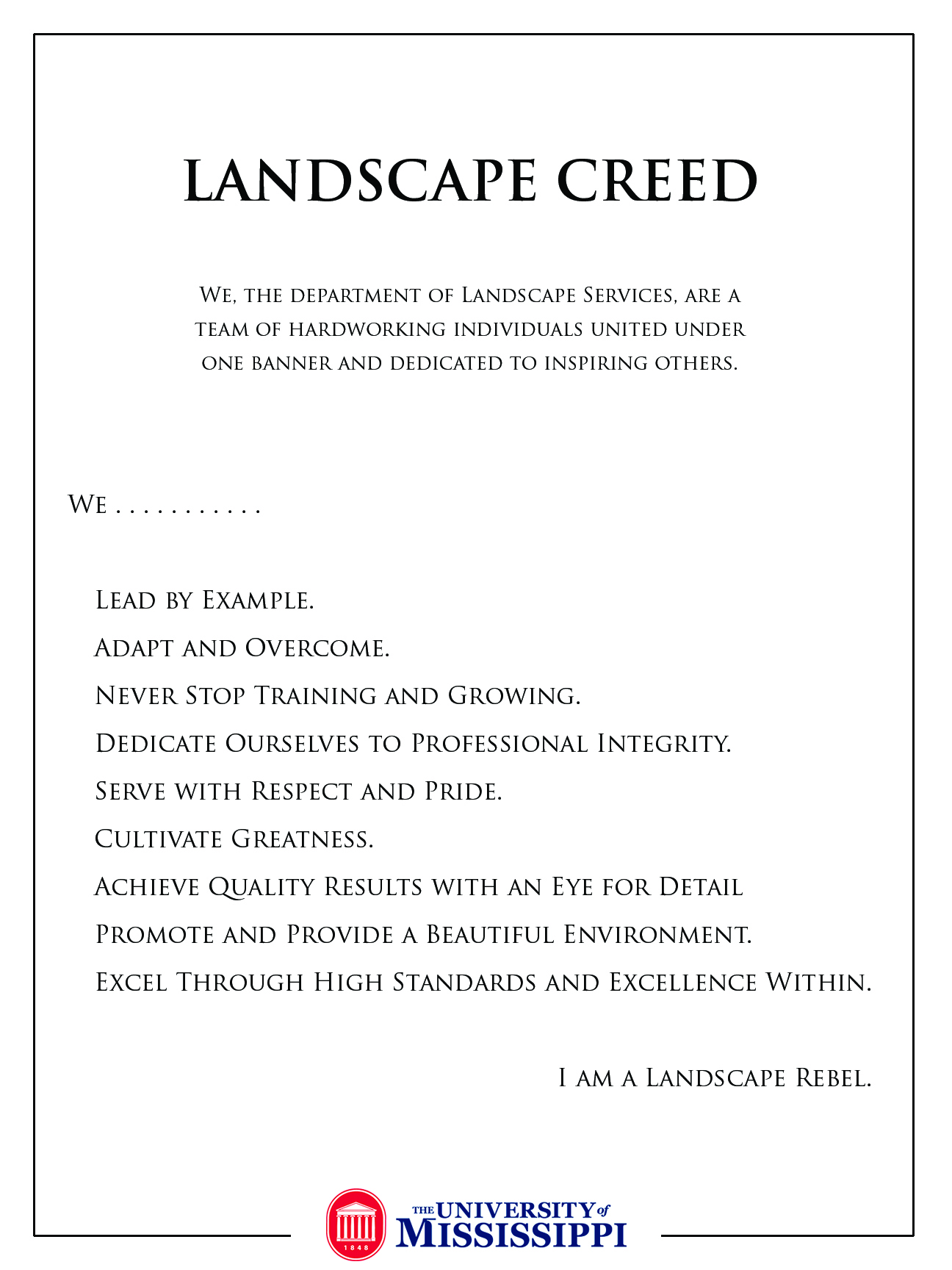Ole Miss Tree Trail
*View Tree Trail in a larger map
Download the Tree Trail PDF1 - Leyland Cypress (Cupressocyparis ×leylandii) Leyland Cypresses were discovered in 1888 when C.J. Leyland found six seedlings growing at Leighton Hall in the South of Wales. The two parent trees cross-bred accidentally---a rare occurrence in conifers. Mr. Leyland continued to develop the trees, and in 1941 the first rooted cuttings arrived in California.
2 - Tulip Poplar (Liriodendron tulipifera) The Tulip Poplar is actually a member of the magnolia family, not the poplar family. Pioneers would use the tulip poplar to make houses, barns and canoes. It is the state tree of Tennessee, Kentucky, and Indiana.
3 - Bradford Pear (Pyrus calleryana 'Bradford') These trees have a relatively short lifespan, needing replacement every 15-20 years. The weak branching structure can cause the tree to split and sometimes fall apart during strong winds.
4 - Yoshino Cherry (Prunus ×yedoensis) In 1909 First Lady Taft agreed to accept a donation of 2,000 cherry trees given on behalf the city of Tokyo. When they arrived they were diseased and infested and had to be burnt. Tokyo then made a second donation of over 3000 trees to be planted in and around Washington, D.C. The city now holds an annual Cherry Blossom Festival to celebrate this beautiful tree.
5 - Little Gem Magnolia (Magnolia grandiflora 'Little Gem') The 'Little Gem' is very similar to Southern Magnolia, only much smaller. 'Little Gem' Magnolias reach only 1/4 the size of a Southern Magnolia and produce the same beautiful white flowers and leaves, only proportionally smaller.
6 - Dawn Redwood (Metasequoia) is a fast-growing deciduous tree. It is native to the Sichuan-Hubei region of China and grows to at least 200 feet (60 meters) in height. Fossils in the Northern parts of the United States show that the dawn redwood knew the dinosaurs. One specimen in Virginia grew 120 feet in 30 years.
7 - Osage Orange (Maclura pomifera) The Osage was often used by ranchers as a natural property fence. The Osage's strong wood, hardy nature and thorny branches all combined to make hedges that were effective in holding in livestock. There is a festival in Texas (Bois d'Arc Bash) "dedicated to celebrating this this hard, durable, and tough tree." The Mississippi Champion Osage Orange is located near the University Museum.
There are 2 Champion Trees on the Ole Miss Campus: the Northern Catalpa and the Osage Orange.
8 - Bald Cypress (Taxodium distichum) Growing slowly, the bald cypress will get taller and taller for roughly 200 years, reaching heights of up to 150 feet. The trees usually live for 600 years, though some specimens are said to have survived for more than 1,000 years. It displays a peculiar habit of raising conical "knees" from its roots. The function of these growths is a mystery.
9 - Drake Elm (Ulmus parvifolia 'Drake') The Chinese elm is native to China, Korea, and Japan. The flowers are produced in early autumn, small and inconspicuous, with the seed maturing rapidly and dispersing by late autumn. The fruit are round samaras appearing in the fall.
10 - White Oak (Quercus alba) White oak is among the most important of all American trees. Some of the uses for its wood included shipbuilding, barrel making and supporting timbers in colonial times, supplanted now by utilization in flooring, cabinets, furniture and as railroad ties. White oak is an exceptional species for large landscaping purposes, providing shade as well as acorns for wildlife to feed on.
11 - Sweet Bay Magnolia (Magnolia virginiana) The Houma tribes of Louisiana and Rappahannock people of Virginia used its leaves, bark, and roots medicinally. Colds, rheumatism, pleurisy, cough, consumption, typhoid fever and autumnal fever were managed by the use of sweetbay tissues and juices. They also enjoyed sweetbay for its hallucinogenic properties. Crushing the leaves will give off a bay scent.
12 - Japanese Magnolia (Magnolia ×soulangiana) a.k.a. Saucer Magnolia - These Magnolias are early bloomers that begin to show in early March, causing the drabness of winter to disappear quickly. When Saucer Magnolias bloom, spring is right around the corner. This tree gets its name from the blooms resembling a cup and saucer.
14 - Red Maple (Acer rubrum) Brilliant fall coloring is one of the outstanding features of red maple. Red maple is a highly desirable wildlife browse food. Elk and white-tailed deer especially use the current season's growth of red maple and aspen as an important source of winter food.
15 - Water Oak (Quercus nigra) Water Oak, a White Oak cultivar, has been used for timber and for fuel by people in the southern states since the 17th century. Other names include spotted oak, duck oak, punk oak, orange oak or possum oak.
16 - Japanese Maple (Acer palmatum) The Japanese Maple was named by Swedish doctor-botanist Carl Peter Thunberg, who traveled in Japan in the late 1700's and returned with drawings of this small tree. He gave it the species epithet "palmatum," after the hand-like shape of its leaves. Japanese gardeners referred to this group of maples as "kaede" and "momiji," referring to "frogs' hands" or "babies' hands."
17 - Forest Pansey Red Bud (Cercis canadensis) Redbud is also known as "The Judas Tree" because, according to legend, Judas Iscariot used an old world relative of redbud to hang himself. This is why the tree is now so weak-wooded; it refuses to grow branches that would be strong enough to hang another.
18 - Crape Myrtle (Lagerstroemia) Nicknamed the lilac of the south, crape myrtle is a summer flowering deciduous tree or large shrub characterized by showy, fragrant blooms. The low maintenanance plant is especially popular in the southern United States.
19 - Willow Oak (Quercus phellos) The Willow oak is one of the most popular trees for horticultural planting, due to its rapid growth, hardiness, balance between axial and radial dominance, ability to withstand both sun and shade, light green leaf color and full crown.
The two Willow Oak trees near J.D. Williams Library were planted on Arbor Day in 1932 to commemorate George Washington's bicentennial birthday. These two trees are appropriately named George and Martha.
20 - Pecan (Carya illinoensis) Texas adopted the pecan tree as its state tree in 1919. In fact, Texas Governor James Hogg liked pecan trees so much that he asked if a pecan tree could be planted at his gravesite when he died.
21 - Southern Magnolia (Magnolia grandiflora) The Mississippi state Legislature officially adopted the southern magnolia as the state tree in 1938. Commonly referred to as the Magnolia State, Mississippi is the only state with the southern magnolia and its blossom representing the state tree and flower. The National Champion southern magnolia is located in Smith County, MS and is over 122 feet tall and the trunk is over 6 feet wide.
22 - Northern Catalpa (Catalpa Speciosa) – a medium-sized deciduous tree growing to 15-30 meters tall and 12 meters wide. The leaves are deciduous, large, heart shaped, 20-30cm long and 15-20 cm broad, pointed at the tip and softly hairy beneath. This specimen belongs to the trumpet-creeper family, a group of mostly tropical plants. Can grow 100 feet tall, but average between 60 feet and 80 feet. The southern is the smaller species, averaging 50 feet. It bears heart shaped leaves and white bell shape flowers covering the tree in late spring to early summer. The common name of "cigar tree" is given due to the 10-24 inch seedpod that looks like an exaggerated green bean. The pods mature in the fall and turn brown and split open lengthwise to release the seeds, resembling a cigar.
23 - Ligustrum japonicum (Japanese privet) a species of Ligustrum native to central and southern Japan and Korea. It's an evergreen shrub or small tree growing between 2-5 m tall with smooth, pale grey-brown bark on the stems. The leaves are 5-10 cm long and 2-5 cm broad, glossy dark green on top and a paler glaucous to yellowish green below with a thick and leathery texture.
24 - Maidenhair Tree (Ginkgo biloba) Ginkgo's tenacity may be seen in Hiroshima, Japan, where six trees growing between 1–2 km from the 1945 atom bomb explosion were among the few living things in the area to survive the blast. While almost all other plants (and animals) in the area were destroyed, the ginkgos, though charred, survived and were soon healthy again. The trees are alive to this day.
25 - Black Walnut (Juglans nigra) The black walnut tree is among the most popular hardwoods for making gunstocks and furniture. Native Americans made a tea from the bark of the black walnut tree to use as a laxative or to induce vomiting. They also chewed on the bark to relieve toothaches.

